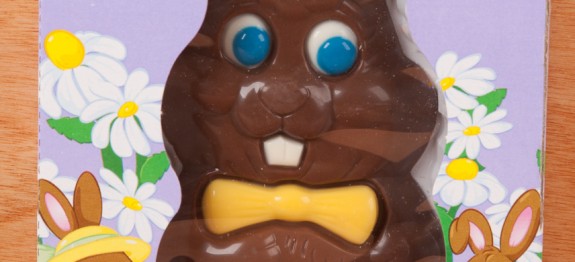Chocolate Easter Bunnies to Avoid
Chocolate Easter Bunnies are as common in the United States as colored hard cooked eggs and chocolate Easter eggs. Who can’t resist giving their child or children a smiling chocolate Easter Bunny? I had my share as a child. But what we ate 50 years ago isn’t the same as what’s available today even when made by the same company. One example is this Palmer Easter Bunny.

If you read the Palmer quality pledge, you’d believe you are buying a high quality product. After all it says so in the second line of their pledge.
But, if you read the ingredients list directly believe it paints a different picture.

All milk chocolate is loaded with sugar. Cocoa is naturally bitter. So sugar isn’t unusual unless you are against eating granulated white sugar.
Before you get to the cocoa, there is partially hydrogenated vegetable oil which contains trans fat, whey a byproduct of cheese making, crisp rice (providing more sugar) and cocoa. It doesn’t take a lot of cocoa to make this milk chocolate rabbit.
What follows is the worst part, a list of artificial ingredients:
- Vanillin
- FD&C Blue #1
- Blue #2
- Red #40
- Yellow #5 and Yellow #6 Lakes
- Red #3.
If that isn’t bad enough, you need to avoid this bunny if you or your children have celiac disease or are allergic to peanuts or tree nuts.
Vanillin is used to flavor many low cost milk chocolate including Hershey’s.
The artificial colors are used for the sugar eyes, tooth, and bow tie.
Partially hydrogenated oils even when they provide less than 0.5 g of trans fat per serving, vanillin, and artificial colors (six in this case) are not what I call fine ingredients. They are low cost ingredients to produce a low cost product.
The nutrition facts label provides more clues into this deceptively smirking rabbit.

This rabbit weighs 72 g, about 2.5 ounces, the size of a large candy bar. What child is going eat half unless told to share with a sibling.
Eat the entire rabbit and you get:
- 360 calories
- 18 g saturated fat
- 40 g of sugar (10 teaspoons)
Milk chocolate is mostly sugar and fat no matter what brand you buy. The decision is whether or not to pay more for a higher quality product.
With the controversy surrounding artificial colors and their affect on children, you should avoid giving your children any candy made with artificial colors.


